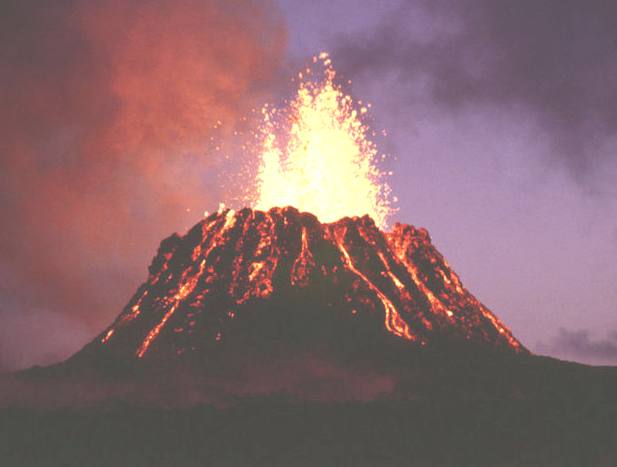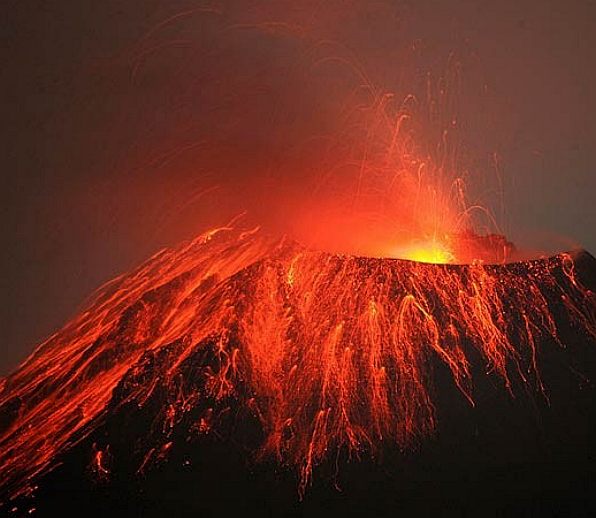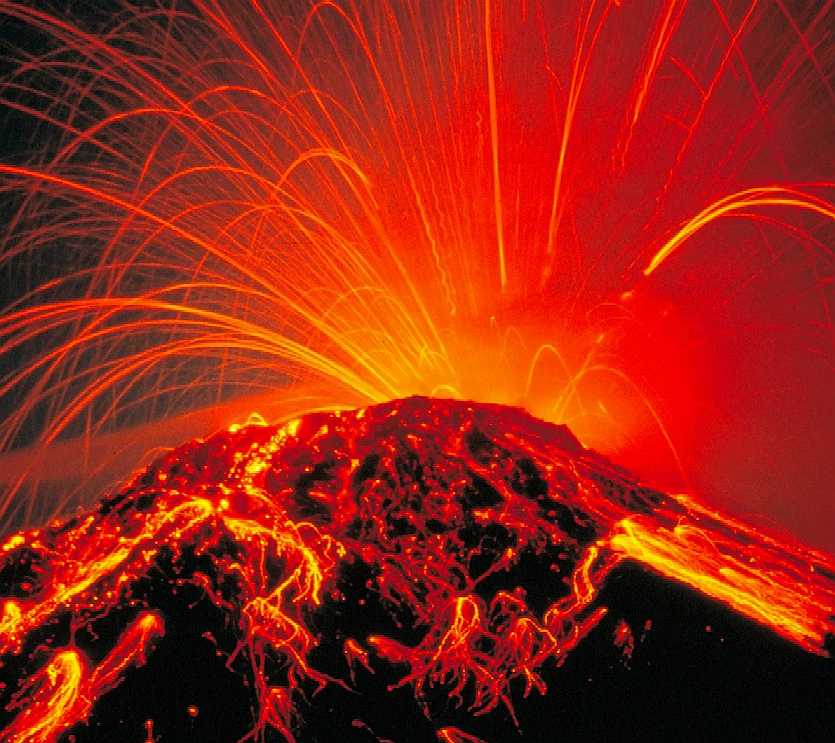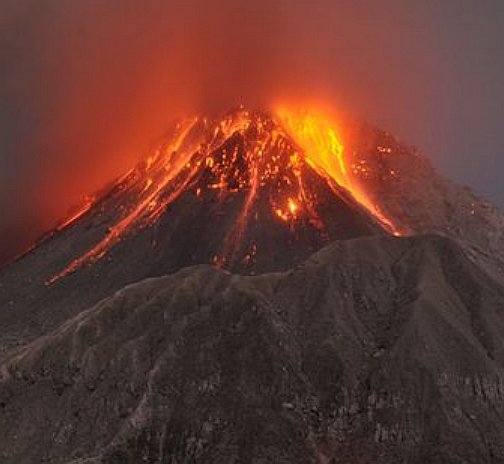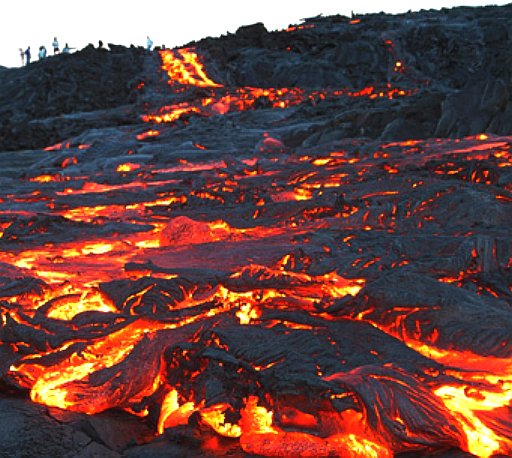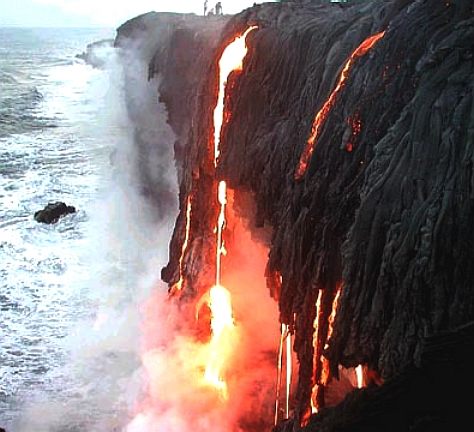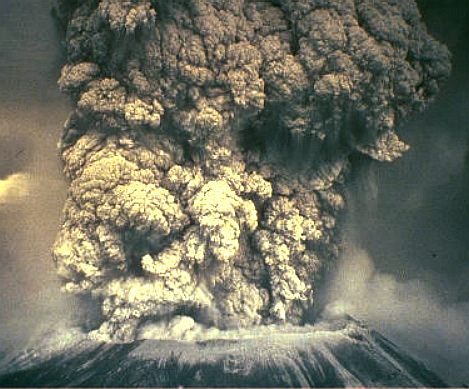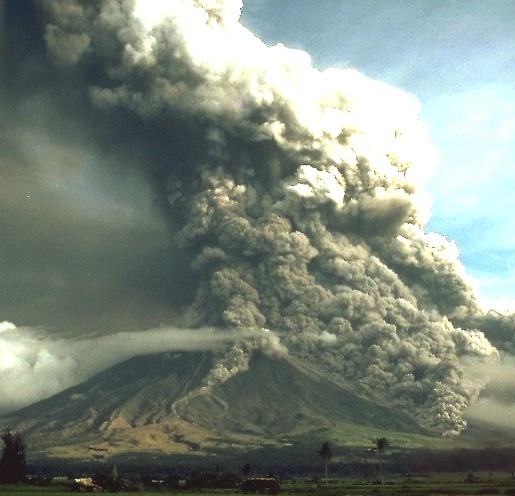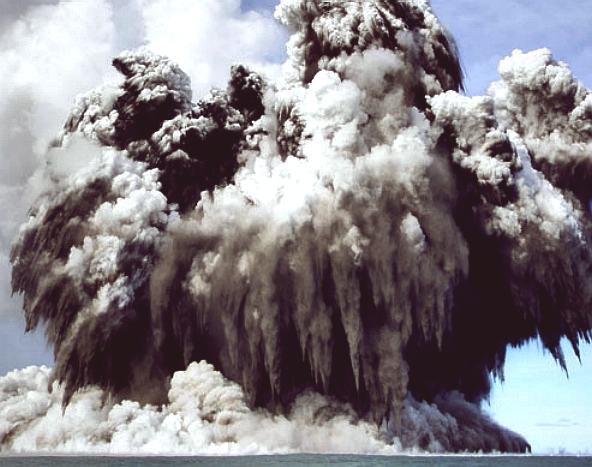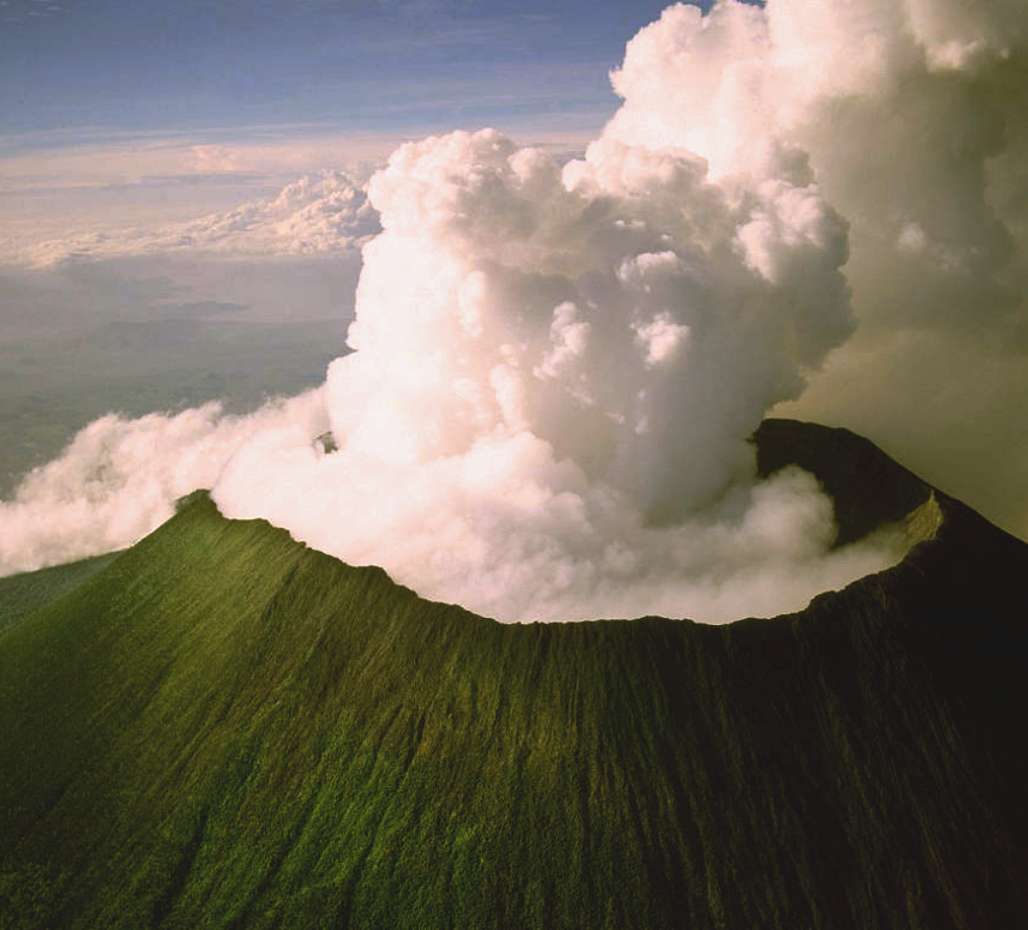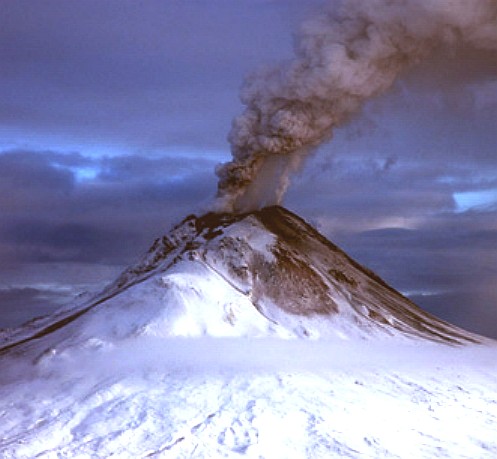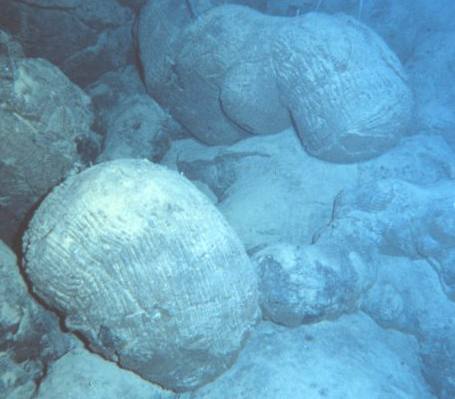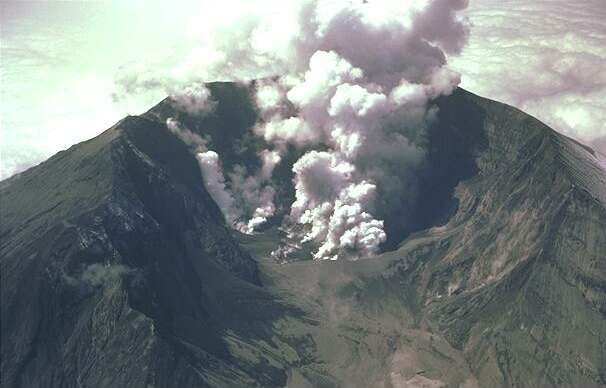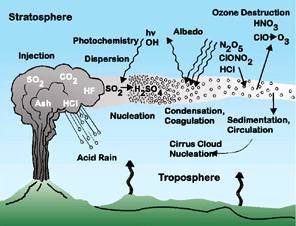|
VOLCANOES
|
||||||||||||||||||||||||||||||||||||||||||||||
|
HOME | BIOLOGY | BOOKS | FILMS | GEOGRAPHY | HISTORY | INDEX | INVESTORS | MUSIC | NEWS | SOLAR BOATS | SPORT |
||||||||||||||||||||||||||||||||||||||||||||||
|
When I was a child I was mesmerized by the opening scene in One Million Years BC, where the volcano erupted. Later the 1969 film 'Krakatoa East of Java' caught my attention and then I visited the slightly fuming Vesuvius in Italy when on holiday with my family. If you've not seen or smelt the yellow sulfurous gas from a volcano, you're missing out on one of natures spectacles. Take a trip to Herculaneum, also along the coast (Bay 0f Naples) and see the mummified ash remains of the inhabitants of that unfortunate port when they were buried alive in choking hot ash. Volcanoes have been taking lives and property from humans since the dawn of time and that will never change.
A volcano is a geological landform usually generated by the eruption through a vent in a planet's surface of magma, molten rock welling up from the planet's interior. Volcanoes of various types are found on other planets and their moons as well as on earth. Roughly defined, a volcano consists of a magma chamber, pipes and vents. The magma chamber is where magma from deep within the planet pools, while pipes are channels that lead to surface vents, openings in the volcano's surface through which lava is ejected during an eruption.
Though the common perception of a volcano as a mountain spewing lava and poisonous gases from a crater in its top is not wrong per se, the features of volcanoes are much more complicated and vary from volcano to volcano depending on a number of factors. Some volcanoes even have rugged peaks formed by lava domes rather than a summit crater, whereas yet others present landscape features such as massive plateaus. Vents that issue volcanic material (lava, which is what magma is called once it has broken the surface, and ash) and gases (mainly steam and magmatic gases) can be located anywhere on the landform. Many of these vents give rise to smaller cones such as Pu‘u ‘Ō‘ō on a flank of Hawaii's Kilauea.
Pu‘u ‘Ō‘ō on a flank of Hawai‘i's Kilauea Volcano
Other types of volcanoes include ice volcanoes (particularly on some moons of Jupiter, Saturn and Neptune) and mud volcanoes. Mud volcanoes are formations often not associated with known magmatic activity. Active mud volcanoes tend to involve temperatures much lower than those of igneous volcanoes, except when a mud volcano is actually a vent of an igneous volcano. On Earth, volcanoes tend to occur near the boundaries of crustal plates. Important exceptions exist in hotspot volcanoes, which occur at locations far from plate boundaries; hotspot volcanoes are also found elsewhere in the solar system, especially on its rocky planets and moons.
A popular way of classifying magmatic volcanoes goes by their frequency of eruption, with those that erupt regularly called active, those that have erupted in historical times but are now quiet called dormant, and those that have not erupted in historical times called extinct. However, these popular classifications—extinct in particular—are practically meaningless to scientists. More significant ones refer to a particular volcano's formative and eruptive processes and resulting shapes; these and other details are explained below. Volcano is thought to derive from Vulcano, a volcanic island in the Aeolian Islands of Italy whose name in turn originates from Vulcan, the name of a god of fire in Roman mythology. The study of volcanoes is called volcanology, sometimes spelled vulcanology.
The Roman name for the island Vulcano has contributed the word for volcano in most modern European languages.
Volcano classification
Erupted material
Lava composition
One way of classifying volcanoes is by the composition of material erupted (lava), since this affects the shape of the volcano. Lava can be broadly classified into 4 different compositions (Cas & Wright, 1987):
Lava texture
Two types of lava are erupted according to the surface texture: 'A'a (pronounced "a-ah") and pahoehoe ("pa-HOY-HOY"), both words having Hawaiian origins. 'A'a is characterized by a rough, clinkery surface and is what most viscous and hot lava flows look like. However, even basaltic or mafic flows can be erupted as 'a'a flows, particularly if the eruption rate is high and the slope is steep. Pahoehoe is characterized by its smooth and often ropy or wrinkly surface and is generally formed from more fluid lava flows. Usually, only mafic flows will erupt as pahoehoe, since they often erupt at higher temperatures or have the proper chemical makeup to allow them to flow at a higher fluidity.
Shape
Shield volcanoes
Hawaii and Iceland are examples of places where volcanoes extrude huge quantities of basaltic lava that gradually build a wide mountain with a shield-like profile. Their lava flows are generally very hot and very fluid, contributing to long flows. The largest lava shield on Earth, Mauna Loa, rises over 9,000 m from the ocean floor, is 120 km in diameter and forms part of the Big Island of Hawaii. Olympus Mons is the largest shield volcano on Mars, and is the tallest mountain in the known solar system. Smaller versions of shield volcanoes include lava cones, and lava mounds.
Quiet eruptions spread out basaltic lava in flat layers. The buildup of these layers form a broad volcano with gently sloping sides called a shield volcano. Examples of shield volcanoes are the Hawaiian Islands.
Cinder cones
Volcanic cones or cinder cones result from eruptions that throw out mostly small pieces of scoria and pyroclastics (both resemble cinders, hence the name of this volcano type) that build up around the vent. These can be relatively short-lived eruptions that produce a cone-shaped hill perhaps 30 to 400 m high. Most cinder cones erupt only once. Cinder cones may form as flank vents on larger volcanoes, or occur on their own. Paricutin in Mexico and Sunset Crater in Arizona are examples of cinder cones.
Stratovolcanoes
These are tall conical mountains composed of lava flows and other ejecta in alternate layers, the strata that give rise to the name. Stratovolcanoes are also known as composite volcanoes. Classic examples include Mt. Fuji in Japan, Mount Mayon in the Philippines, and Mount Vesuvius and Stromboli in Italy.
Supervolcanoes
Supervolcano is the popular term for large volcanoes that usually have a large caldera and can potentially produce devastation on an enormous, sometimes continental, scale. Such eruptions would be able to cause severe cooling of global temperatures for many years afterwards because of the huge volumes of sulfur and ash erupted. They can be the most dangerous type of volcano. Examples include Yellowstone Caldera in Yellowstone National Park and Lake Toba in Sumatra, Indonesia. Supervolcanoes are hard to identify given their enormous areas covered. They are also known as flood basalt events due to the large amounts of basalt ejected.
Pillow lava (NOAA)
Submarine volcanoes
Submarine volcanoes are common features on the ocean floor. Some are active and, in shallow water, disclose their presence by blasting steam and rocky debris high above the surface of the sea. Many others lie at such great depths that the tremendous weight of the water above them prevents the explosive release of steam and gases, although they can be detected by hydrophones and discoloration of water due to volcanic gases. Even large submarine eruptions may not disturb the ocean surface. Submarine volcanoes often form rather steep pillars and in due time, may break the ocean surface as new islands. Pillow lava is a common eruptive product of submarine volcanoes.
Subglacial volcanoes
Subglacial volcanoes develop underneath icecaps. They are made up of flat lava flows atop extensive pillow lavas and palagonite. When the icecap melts, the lavas on the top collapse leaving a flat-topped mountain. Then, the pillow lavas also collapse, giving an angle of 37.5 degrees. Very good examples of this can be seen in Iceland. These volcanoes are also called table volcanoes or mobergs.
Classifying volcanic activity
Volcanoes are usually situated either near the boundaries between tectonic plates or over geologically active hotspots. Volcanoes may be either dormant (having no activity) or active (currently erupting) or extinct (no longer active at all).
Surprisingly, there is no real consensus among volcanologists on how to define an "active" volcano. The lifespan of a volcano can vary from months to several million years, making such a distinction sometimes meaningless when compared to the lifespans of humans or even civilizations. For example, many of Earth's volcanoes have erupted dozens of times in the past few thousand years but are not currently showing signs of eruption. Given the long lifespan of such volcanoes, they are very active. By our lifespans, however, they are not. Complicating the definition are volcanoes that become restless (producing earthquakes, venting gasses, or other non-eruptive activities) but do not actually erupt.
Scientists usually consider a volcano active if it is currently erupting or showing signs of unrest, such as unusual earthquake activity or significant new gas emissions. Many scientists also consider a volcano active if it has erupted in historic time. It is important to note that the span of recorded history differs from region to region; in the Mediterranean, recorded history reaches back more than 3,000 years but in the Pacific Northwest of the United States, it reaches back less than 300 years, and in Hawaii, little more than 200 years. The Smithsonian Global Volcanism Program's definition of 'active' is having erupted within the last 10,000 years.
Mount St. Helens shortly after the eruption of May 18, 1980
Dormant volcanoes are those that are not currently active (as defined above), but could become restless or erupt again. Confusion however, can arise because many volcanoes which scientists consider to be active are referred to as dormant by laypersons or in the media.
Extinct volcanoes are those that scientists consider unlikely to erupt again. Whether a volcano is truly extinct is often difficult to determine. Since "supervolcano" calderas can have eruptive lifespans sometimes measured in millions of years, a caldera that has not produced an eruption in tens of thousands of years is likely to be considered dormant instead of extinct.
For example, the Yellowstone Caldera in Yellowstone National Park is at least 2 million years old and hasn't erupted violently for approximately 640,000 years, although there has been some minor activity relatively recently, with hydrothermal eruptions less than 10,000 years ago and lava flows about 70,000 years ago. For this reason, scientists do not consider the Yellowstone Caldera extinct. In fact, because the caldera has frequent earthquakes, a very active geothermal system (i.e., the entirety of the geothermal activity found in Yellowstone National Park), and rapid rates of ground uplift, many scientists consider it to be an active volcano.
Notable volcanoes
Volcanoes on Earth
The 16 current Decade Volcanoes are:
Volcanoes elsewhere in the solar system
The Earth's Moon has no large volcanoes, but does have many volcanic features such as maria (the darker patches seen on the moon), rilles and domes. The planet Venus has a surface that is 90% basalt, indicating that volcanism played a major role in shaping its surface. The planet may have had a major global resurfacing event about 500 million years ago, from what scientists can tell from the density of impact craters on the surface. Lava flows are widespread and forms of volcanism not present on Earth occur as well. Changes in the planet's atmosphere and observations of lightning, have been attributed to ongoing volcanic eruptions, although there is no confirmation of whether or not Venus is still volcanically active.
There are several extinct volcanoes on Mars, four of which are vast shield volcanoes far bigger than any on Earth. They include Arsia Mons, Ascraeus Mons, Hecates Tholus, Olympus Mons, and Pavonis Mons. These volcanoes have been extinct for many millions of years, but the European Mars Express spacecraft has found evidence that volcanic activity may have occurred on Mars in the recent past as well.
Jupiter's moon Io is the most volcanically active object in the solar system, due to tidal interaction with Jupiter. It is covered with volcanoes that erupt sulfur, sulfur dioxide and silicate rock, and as a result, Io is constantly being resurfaced. Its lavas are the hottest known anywhere in the solar system, with temperatures exceeding 1,800 K (1,500 °C). In February 2001, the largest recorded volcanic eruptions in the solar system occurred on Io. Europa, the smallest of Jupiter's Galilean moons, also appears to have an active volcanic system, except that its volcanic activity is entirely in the form of water, which freezes into ice on the frigid surface. This process is known as cryovolcanism, and is apparently most common on the moons of the outer planets of the solar system.
In 1989 the Voyager 2 spacecraft observed ice volcanoes (cryovolcanism) on Triton, a moon of Neptune, and in 2005 the Cassini-Huygens probe photographed fountains of frozen particles erupting from Saturn's moon Enceladus. The ejecta may be composed of water, liquid nitrogen, dust, or methane compounds. Cassini-Huygens also found evidence of a methane-spewing cryovolcano on the Saturnian moon Titan, which is believed to be a significant source of the methane found in its atmosphere. It is theorized that cryovolcanism may also be present on the Kuiper Belt Object Quaoar.
Volcanic "injection"
Effects of volcanoes
There are many different kinds of volcanic activity and eruptions: phreatic eruptions (steam-generated eruptions), explosive eruption of high-silica lava (e.g., rhyolite), effusive eruption of low-silica lava (e.g., basalt), pyroclastic flows, lahars (debris flow) and carbon dioxide emission. All of these activities can pose a hazard to humans. Volcanic activity is often accompanied by earthquakes, hot springs, fumaroles, mud pots and geysers. Low-magnitude earthquakes often precede eruptions.
The concentrations of different volcanic gases can vary considerably from one volcano to the next. Water vapor is typically the most abundant volcanic gas, followed by carbon dioxide and sulfur dioxide. Other principal volcanic gases include hydrogen sulfide, hydrogen chloride, and hydrogen fluoride. A large number of minor and trace gases are also found in volcanic emissions, for example hydrogen, carbon monoxide, and volatile metal chlorides.
Large, explosive volcanic eruptions inject water vapor (H2O), carbon dioxide (CO2), sulfur dioxide (SO2), hydrogen chloride (HCl), hydrogen fluoride (HF) and ash (pulverized rock and pumice) into the stratosphere to heights of 10-20 miles above the Earth's surface. The most significant impacts from these injections come from the conversion of sulfur dioxide to sulfuric acid (H2SO4), which condenses rapidly in the stratosphere to form fine sulfate aerosols. The aerosols increase the Earth's albedo—its reflection of radiation from the Sun back into space - and thus cool the Earth's lower atmosphere or troposphere; however, they also absorb heat radiated up from the Earth, thereby warming the stratosphere. Several eruptions during the past century have caused a decline in the average temperature at the Earth's surface of up to half a degree (Fahrenheit scale) for periods of one to three years. The sulfate aerosols also promote complex chemical reactions on their surfaces that alter chlorine and nitrogen chemical species in the stratosphere. This effect, together with increased stratospheric chlorine levels from chlorofluorocarbon pollution, generates chlorine monoxide (ClO), which destroys ozone (O3). As the aerosols grow and coagulate, they settle down into the upper troposphere where they serve as nuclei for cirrus clouds and further modify the Earth's radiation balance. Most of the hydrogen chloride (HCl) and hydrogen fluoride (HF) are dissolved in water droplets in the eruption cloud and quickly fall to the ground as acid rain. The injected ash also falls rapidly from the stratosphere; most of it is removed within several days to a few weeks. Finally, explosive volcanic eruptions release the greenhouse gas carbon dioxide and thus provide a deep source of carbon for biogeochemical cycles.
Gas emissions from volcanoes are a natural contributor to acid rain. Volcanic activity releases about 130 to 230 teragrams (145 million to 255 million short tons) of carbon dioxide each year. Volcanic eruptions may inject aerosols into the Earth's atmosphere. Large injections may cause visual effects such as unusually colorful sunsets and affect global climate mainly by cooling it. Volcanic eruptions also provide the benefit of adding nutrients to soil through the weathering process of volcanic rocks. These fertile soils assist the growth of plants and various crops. Volcanic eruptions can also create new islands, as the magma dries on the water.
Past beliefs
Before it was understood that most of the Earth's interior is molten, various explanations existed for volcano behavior. For decades after awareness that compression and radioactive materials may be heat sources, their contributions were specifically discounted. Volcanic action was often attributed to chemical reactions and a thin layer of molten rock near the surface. Many ancient accounts claim that divine intervention was the actual cause of volcanic eruptions.
One early idea counter to this, however, was Jesuit Athanasius Kircher (1602-1680), who witnessed eruptions of Aetna and Stromboli, then visited the crater of Vesuvius and published his view of an Earth with a central fire connected to numerous others caused by the burning of sulfur, bitumen and coal.
LINKS
.. Thirst for Life
330ml Earth can - the World in Your Hands
|
||||||||||||||||||||||||||||||||||||||||||||||
|
This website is Copyright © 1999 & 2012 Max Energy Limited, an educational charity working for world peace. The bird logos and names Blueplanet Ecostar, Solar Navigator and Utopia Tristar are trademarks. All rights reserved. |
||||||||||||||||||||||||||||||||||||||||||||||
|
AUTOMOTIVE | BLUEPLANET | ELECTRIC CARS | ELECTRIC CYCLES | SOLAR CARS | SOLARNAVIGATOR | UTOPIA |
